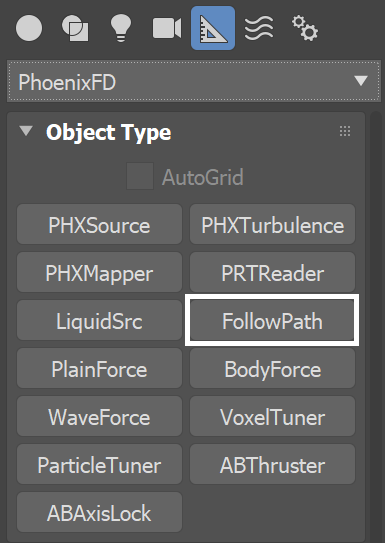This page provides information on the Follow Path component.
Overview
The Follow Path helper force pushes a fluid along a spline curve.
The degree of force is controlled by a virtual pipe around the spline.
For points outside the pipe, the force pushes the fluid toward the spline. For points inside the pipe, the force pushes the fluid along the spline, in one direction.
To create balance between predictability and the randomness of natural behavior, two important values are used: terminal velocity and influence.
The terminal velocity is the maximum velocity a particle can reach, and is set by the Follow Speed, Pull Speed, and Rotation Speed parameters.
Meanwhile, the Influence parameter determines the degree to which terminal velocity is used, instead of fluid dynamics.
Parameters
Spline | spline – Specifies the spline object providing the path.
Follow Speed | axsp – Specifies the terminal velocity of the fluid moving along the spline. This part of the force is most pronounced inside the pipe.
Pull Speed | radsp – Specifies the terminal velocity of the fluid moving toward the spline. This part of the force is most pronounced outside the pipe.
Rotation Speed | orbsp – Specifies the terminal velocity of the fluid that flows around the spline.
Influence | strength – When a fluid's velocity is being calculated, there are two calculations in play: the terminal velocity specified by the speed parameters on this rollout, and the simulator's calculation of fluid velocity based on fluid dynamics. The Influence parameter determines the degree to which terminal velocity is used instead of fluid dynamics when calculating speed and direction. A value of 0 relies entirely on fluid dynamics while a value of 1 means the fluid's velocity is set immediately to terminal velocity. Intermediate values give the fluid a certain degree of freedom to respond to fluid dynamics, which provides some natural variation while giving a degree of predictability.
To simulate liquid that is constantly accelerating (such as free-falling liquid reacting to gravity), use a high terminal velocity and a very low Influence value.
Sub Segments | subsegments – Breaks the spline into several parts of equal size. Each sub segment influences the simulation separately, allowing the force effect to accumulate over areas with multiple segments nearby.
Max Distance | maxdist – Specifies the distance from the spline at which the force no longer affects the fluid.
Fade Start | fadestart – Specifies the relative distance (as part of the Max Distance) where the force starts to decline, expressed as a decimal fraction.
Pipe Radius | radius – The radius of the virtual pipe used to determine where the Follow Speed is replaced with the Pull Speed.
Affect | affect – Specifies the affected components of the simulation separated by commas. Any unknown element found in the list is ignored. The supported elements are:
Liquid - affects the Liquid particles in a Liquid simulation.
Splashes - affects the Splash particles in a Liquid simulation.
Foam - affects the Foam particles in a Liquid simulation.
Mist - affects the Mist particles in a Liquid simulation.
Air - affects the space in a Liquid simulation where there are no Liquid particles, when Simulate Air Effects is enabled in the Dynamics rollout. All particles such as Foam, Splash or Mist outside the liquid volume will be influenced.
Temperature - affects the voxels in a Fire/Smoke simulation where the Temperature is different than the default 300 Kelvins. The higher the temperature above 300 or the lower it is below 300, the stronger the effect of the force would be. You can find out more about Phoenix Grid Channel Ranges here.
Smoke - affects the voxels in a Fire/Smoke simulation where there is Smoke. The denser the smoke, the stronger the effect of the force would be.
Fuel - affects the voxels in a Fire/Smoke simulation where there is Fuel. The denser the fuel, the stronger the effect of the force would be.
Affect Names are not case sensitive and any unknown element found in the list is ignored.


